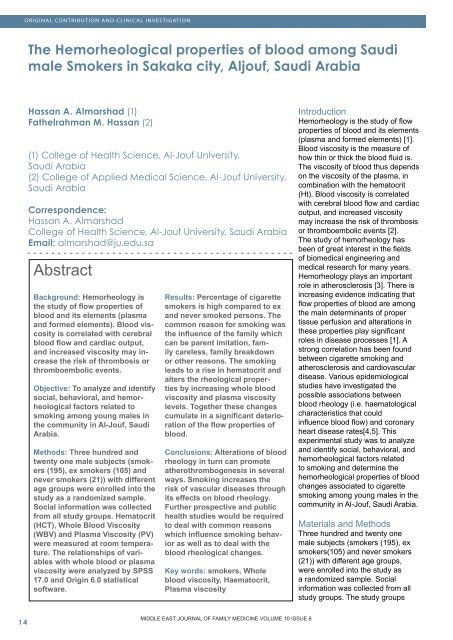full pdf of issue - Middle East Journal of Family Medicine
full pdf of issue - Middle East Journal of Family Medicine
full pdf of issue - Middle East Journal of Family Medicine
Create successful ePaper yourself
Turn your PDF publications into a flip-book with our unique Google optimized e-Paper software.
ORIGINAL CONTRIBUTION AND CLINICAL INVESTIGATION<br />
The Hemorheological properties <strong>of</strong> blood among Saudi<br />
male Smokers in Sakaka city, Aljouf, Saudi Arabia<br />
Hassan A. Almarshad (1)<br />
Fathelrahman M. Hassan (2)<br />
(1) College <strong>of</strong> Health Science, Al-Jouf University,<br />
Saudi Arabia<br />
(2) College <strong>of</strong> Applied Medical Science, Al-Jouf University,<br />
Saudi Arabia<br />
Correspondence:<br />
Hassan A. Almarshad<br />
College <strong>of</strong> Health Science, Al-Jouf University, Saudi Arabia<br />
Email: almarshad@ju.edu.sa<br />
Abstract<br />
Background: Hemorheology is<br />
the study <strong>of</strong> flow properties <strong>of</strong><br />
blood and its elements (plasma<br />
and formed elements). Blood viscosity<br />
is correlated with cerebral<br />
blood flow and cardiac output,<br />
and increased viscosity may increase<br />
the risk <strong>of</strong> thrombosis or<br />
thromboembolic events.<br />
Objective: To analyze and identify<br />
social, behavioral, and hemorheological<br />
factors related to<br />
smoking among young males in<br />
the community in Al-Jouf, Saudi<br />
Arabia.<br />
Methods: Three hundred and<br />
twenty one male subjects (smokers<br />
(195), ex smokers (105) and<br />
never smokers (21)) with different<br />
age groups were enrolled into the<br />
study as a randomized sample.<br />
Social information was collected<br />
from all study groups. Hematocrit<br />
(HCT), Whole Blood Viscosity<br />
(WBV) and Plasma Viscosity (PV)<br />
were measured at room temperature.<br />
The relationships <strong>of</strong> variables<br />
with whole blood or plasma<br />
viscosity were analyzed by SPSS<br />
17.0 and Origin 6.0 statistical<br />
s<strong>of</strong>tware.<br />
Results: Percentage <strong>of</strong> cigarette<br />
smokers is high compared to ex<br />
and never smoked persons. The<br />
common reason for smoking was<br />
the influence <strong>of</strong> the family which<br />
can be parent imitation, family<br />
careless, family breakdown<br />
or other reasons. The smoking<br />
leads to a rise in hematocrit and<br />
alters the rheological properties<br />
by increasing whole blood<br />
viscosity and plasma viscosity<br />
levels. Together these changes<br />
cumulate in a significant deterioration<br />
<strong>of</strong> the flow properties <strong>of</strong><br />
blood.<br />
Conclusions: Alterations <strong>of</strong> blood<br />
rheology in turn can promote<br />
atherothrombogenesis in several<br />
ways. Smoking increases the<br />
risk <strong>of</strong> vascular diseases through<br />
its effects on blood rheology.<br />
Further prospective and public<br />
health studies would be required<br />
to deal with common reasons<br />
which influence smoking behavior<br />
as well as to deal with the<br />
blood rheological changes.<br />
Key words: smokers, Whole<br />
blood viscosity, Haematocrit,<br />
Plasma viscosity<br />
Introduction<br />
Hemorheology is the study <strong>of</strong> flow<br />
properties <strong>of</strong> blood and its elements<br />
(plasma and formed elements) [1].<br />
Blood viscosity is the measure <strong>of</strong><br />
how thin or thick the blood fluid is.<br />
The viscosity <strong>of</strong> blood thus depends<br />
on the viscosity <strong>of</strong> the plasma, in<br />
combination with the hematocrit<br />
(Ht). Blood viscosity is correlated<br />
with cerebral blood flow and cardiac<br />
output, and increased viscosity<br />
may increase the risk <strong>of</strong> thrombosis<br />
or thromboembolic events [2].<br />
The study <strong>of</strong> hemorheology has<br />
been <strong>of</strong> great interest in the fields<br />
<strong>of</strong> biomedical engineering and<br />
medical research for many years.<br />
Hemorheology plays an important<br />
role in atherosclerosis [3]. There is<br />
increasing evidence indicating that<br />
flow properties <strong>of</strong> blood are among<br />
the main determinants <strong>of</strong> proper<br />
t<strong>issue</strong> perfusion and alterations in<br />
these properties play significant<br />
roles in disease processes [1]. A<br />
strong correlation has been found<br />
between cigarette smoking and<br />
atherosclerosis and cardiovascular<br />
disease. Various epidemiological<br />
studies have investigated the<br />
possible associations between<br />
blood rheology (i.e. haematological<br />
characteristics that could<br />
influence blood flow) and coronary<br />
heart disease rates[4,5]. This<br />
experimental study was to analyze<br />
and identify social, behavioral, and<br />
hemorheological factors related<br />
to smoking and determine the<br />
hemorheological properties <strong>of</strong> blood<br />
changes associated to cigarette<br />
smoking among young males in the<br />
community in Al-Jouf, Saudi Arabia.<br />
Materials and Methods<br />
Three hundred and twenty one<br />
male subjects (smokers (195), ex<br />
smokers(105) and never smokers<br />
(21)) with different age groups,<br />
were enrolled into the study as<br />
a randomized sample. Social<br />
information was collected from all<br />
study groups. The study groups<br />
14 MIDDLE EAST JOURNAL OF FAMILY MEDICINE VOLUME 10 ISSUE 6<br />
MIDDLE EAST JOURNAL OF FAMILY MEDICINE • VOLUME 7, ISSUE 10
















